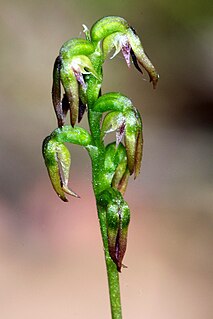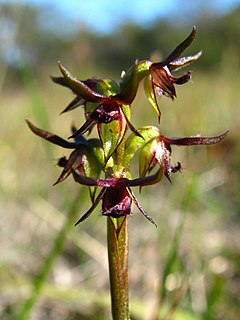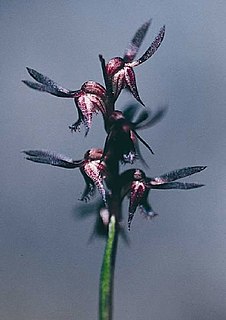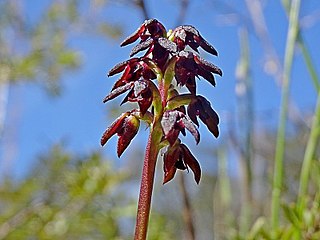
Genoplesium despectans, commonly known as the sharp midge orchid and known as Corunastylis despectans in Australia, is a small terrestrial orchid endemic to south-eastern Australia. It has a single thin leaf fused to the flowering stem and up to forty five small, dark purple or green and purple flowers.

Genoplesium morrisii, commonly known as the bearded midge orchid and known as Corunastylis morrisii in Australia, is a small terrestrial orchid endemic to south-eastern Australia. It has a single thin leaf fused to the flowering stem and up to fifteen small, dark purplish-black or green and purple flowers.

Genoplesium archeri, commonly known as the elfin midge orchid and as Corunastylis archeri in Australia, is a small terrestrial orchid endemic to south-eastern Australia. It has a single thin leaf fused to the flowering stem and up to fifteen small, hairy, yellowish green flowers with purple stripes. It grows in a wide range of habitats in New South Wales, Victoria and Tasmania.

Genoplesium arrectum, commonly known as the erect midge orchid and as Corunastylis arrecta in Australia, is a small terrestrial orchid endemic to south-eastern Australia. It has a single thin leaf fused to the flowering stem and up to twenty small, dark purple flowers. It grows in a montane and subalpine grassland and forest in Victoria and the Australian Capital Territory.
Genoplesium citriodorum, commonly known as the lemon-scented midge orchid is a species of small terrestrial orchid that is endemic to New South Wales. It has a single thin leaf fused to the flowering stem and up to thirty three small, lemon scented, dark purplish black flowers. It usually grows under shrubs in shallow sandstone soil in the Blue Mountains.
Genoplesium eriochilum, commonly known as the Mount Wilson midge orchid, is a species of small terrestrial orchid endemic to the Blue Mountains. It has a single thin leaf fused to the flowering stem and up to twenty small, crowded, dark purplish brown flowers. It usually grows between low shrubs and sedges.
Genoplesium formosum, commonly known as the Cathcart midge orchid is a small terrestrial orchid found in southern New South Wales. It has a single thin leaf and up to twenty five dark reddish purple flowers with darker lines.
Genoplesium insigne, commonly known as the dark midge orchid or Wyong midge orchid is a species of small terrestrial orchid that is endemic to New South Wales. It has a single thin leaf and up to twelve dark purple to dark reddish purple flowers. It is mostly found in heath on the Central Coast and only around fifty plants survive.
Genoplesium morinum, commonly known as the mulberry midge orchid, is a species of small terrestrial orchid that is endemic to New South Wales. It has a single thin leaf fused to the flowering stem and up to twenty crowded, dark reddish purple flowers. It has been known as "mulberries on sticks".
Genoplesium pedersonii, commonly known as Pederson's midge orchid, is a species of small terrestrial orchid endemic to the Blackdown Tableland in Queensland. It has a single thin leaf fused to the flowering stem and up to thirty small, greenish red to reddish, self-pollinating flowers with a dark purplish red labellum. The species is treated as Corunastylis pedersonii in Queensland.

Genoplesium rhyoliticum, commonly known as the Pambula midge-orchid or rhyolite midge orchid and as Corunastylis rhyolitica in Australia, is a species of orchid endemic to New South Wales. It is a small orchid with up to eighteen dark, purplish-black flowers and is only known from six sites on the south coast where it grows in shallow soil over rhyolite.
Genoplesium sigmoideum, commonly known as the Dave's Creek midge orchid, is a species of small terrestrial orchid that is endemic to a small area in the Lamington National Park in Queensland. It has a single thin leaf fused to the flowering stem and up to twenty dark red flowers with a hairy labellum. The species is treated as Corunastylis sigmoidea in Queensland.

Genoplesium vernale, commonly known as the spring midge orchid or East Lynne midge orchid is a small terrestrial orchid which is endemic to a small area on the south coast of New South Wales. It has a single thin leaf and up to twenty five dark purplish-black flowers with tiny glandular hairs on the sepals and petals.
Genoplesium superbum, commonly known as the pink midge orchid or superb midge orchid, is a species of small terrestrial orchid that is endemic to New South Wales. It has a single thin leaf and up to fifteen dark pinkish-purple flowers which lean downwards. It is listed as "endangered" in New South Wales because of its limited distribution and disturbance of its habitat.
Genoplesium superbum, commonly known as the Kangarooby midge orchid, is a species of small terrestrial orchid that is endemic to New South Wales. It has a single thin leaf and up to thirty two hairy, light reddish flowers which lean downwards and have a dark purple labellum.
Genoplesium tasmanicum, commonly known as the Tasmanian midge orchid, is a species of small terrestrial orchid that is endemic to Tasmania. It has a single thin leaf and up to twenty five dark purplish-black and green flowers. It is widespread and common at lower altitudes.
Genoplesium tectum, commonly known as the Cardwell midge orchid, is a small terrestrial orchid endemic to a small area in north-eastern Queensland. It has a single thin leaf fused to the flowering stem and up to thirty light red flowers with a dark reddish-black, hairy labellum.
Genoplesium turfosum, commonly known as the alpine midge orchid, is a small terrestrial orchid endemic to a small area in the higher parts of New South Wales. It has a single thin leaf fused to the flowering stem and up to twenty five dark purplish-red, crowded flowers with a sparsely hairy labellum.
Genoplesium validum, commonly known as the Blackdown midge orchid, is a species of small terrestrial orchid that is endemic to the Blackdown Tableland National Park in Queensland. It has a single thin leaf fused to the flowering stem and up to thirty five greenish-brown flowers with reddish stripes and a hairy labellum. This species is treated as Corunastylis valida in Queensland.
Corunastylis densa, commonly known as the dense midge orchid, is a small terrestrial orchid endemic to eastern Australia. It has a single thin leaf fused to the flowering stem and up to twenty five densely crowded reddish-brown to dark purplish-brown flowers. It is found between the New England National Park and the Moroka River.





